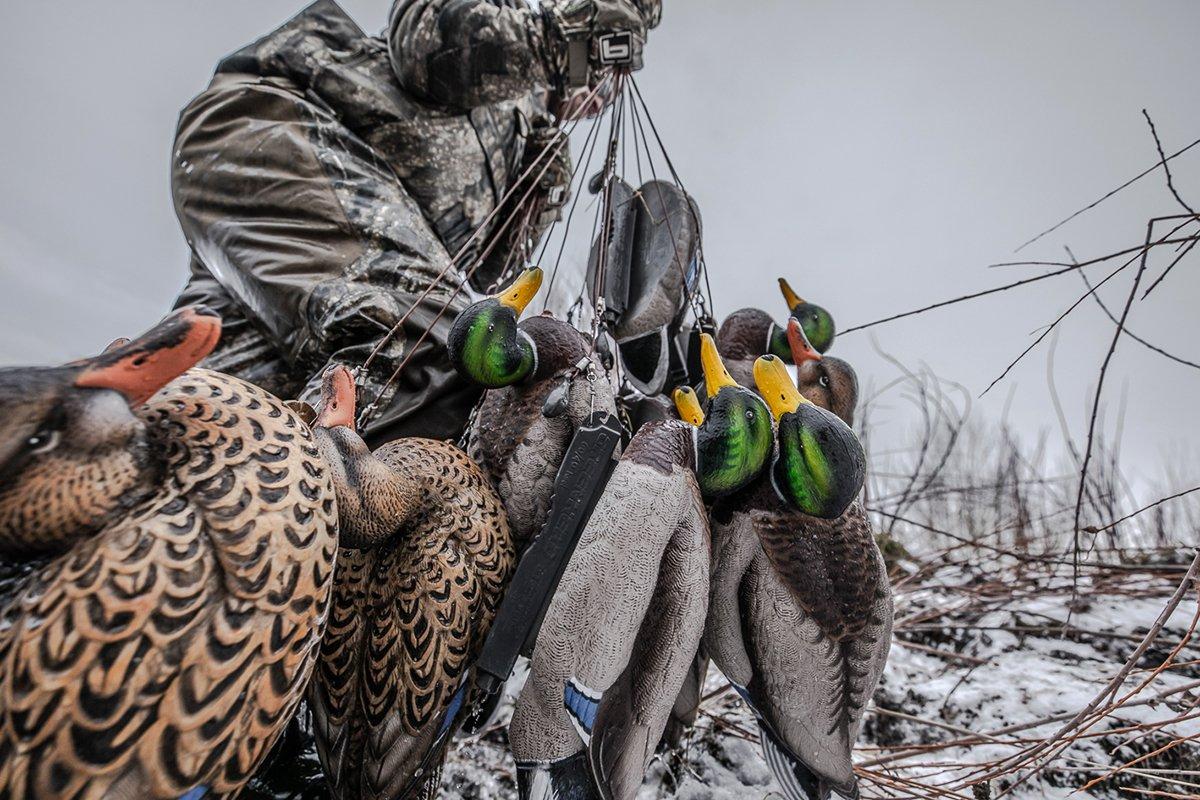Change Your Game to Score Last-Chance Mallards
Long gone are the fair-weather hunters. They Who Only Hunt Early are home sitting by a cozy fire, reading a good duck hunting book and dreaming of blue skies and sort-of-green-headed ducks gliding into serene blocks.
But you are a late-season fanatic.
Yes, you were out there with the bluebird-day duck hunting wannabes. But you are still shunning home and hearth to be sitting next to a steaming spring creek, hunkering on a still-open pothole, reclining under blankets in a muddy or snowy field, or leaning against an oak tree in flooded timber, waiting for an emerald-headed wonder to set its wings and bomb into your setup.
But that isn't always easy to make happen. Chances are those ducks have flown quite a few gauntlets to get here. They are educated by other hunters and time on Earth, and protected by a magnificently suspicious, wary nature that has been honed sharp for survival.
How do you fool such a bird?
There are no catch-all, cure-all answers. The solution involves intense attention to detail and a devoted aversion to relying on hope and prayer to get ducks. In those regards, these seven tips should help you put more late-season greenheads on the duck strap.
Flock Up
How do your decoys look? Even if you tuned and touched them up before the season, chances are they're showing some wear and tear and producing some shine. Nothing flares a wary mallard like an odd sheen or reflection coming off decoys. Now is the time to deploy flocked decoys. Yes, they can cost a bundle. But their realism is uncanny, and that gives you a better chance of fooling those bulging, prying mallard eyes.
Go Small
Bigger is better, right? In most cases, duck hunters want a big spread to attract attention and display a safety-in-numbers mood. But rear-guard ducks have seen that approach. Go smaller — say 15, 13 or 11 blocks. It's almost counterintuitive at this time of year, but it's different and natural, and that makes it work.
Spread 'Em Out
Keep those blocks spread out. With fewer decoys, that helps provide more visibility to birds above and plenty of landing zones for what can be good-sized flocks of migrating birds.
Move When Needed
Don't be a slave to a spot. If you're here and the ducks like it over there, pick up and go over there. Hope and prayer are good things, but with late-season mallards, being where they want to be is even better.
"It happened to me last season," Minnesota duck hunting fanatic Rachel Hoveland said. "Man, I needed a few more ducks for my strap. And man, I didn't want to move. But they liked it off this other point. So I did the work and got over there. Then I was done in 20 minutes."
Be a Statue
Hunting late-show mallards isn't rocket science, but it is hard work. Go every extra mile, yard and inch to stay still, avoid movement and take away as much chance as you can of giving ducks any reason to flare. Be more still than at any other time of year. Wear a facemask in case you can't help peeking (but don't peek if you can help it). Change up the camouflage pattern you wear — consider one such as Realtree Timber or Max-5 — to match the browner surroundings.
Swing Hard
"Late season birds often just won't set their wings and come in all nice and proper, Hoveland said with a laugh. A good buzz-by is all you might get. So be ready for that."
In other words, don't pass up an in-range flock unless you have a really good feeling they've got one more pass left in them.
"Then swing hard and swing fast, Hoveland said. Keep that shotgun moving as you pass the bird and pull the trigger. That builds a natural lead. And keep the gun moving on the follow-through."
Pluck Happily
There is nothing like a late-season mallard for the table. Each bird is exquisitely fat with yellow lard, and the pin feathers are mostly gone. Those factors combine to make plucking a prime way to clean your ducks. If that's too much work during the day of the hunt, hang the birds head down in a cool place where they won't freeze (a garage or shed), and do them in a day or two. There's nothing wrong with that. And the result — a roasted late-show greenhead you worked so hard to bring to hand — is nothing short of culinary heaven.
Click here for more Realtree waterfowl hunting content. And check us out on Facebook.







